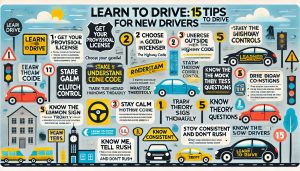 Learn to Drive: 15 Tips for New Drivers
Learn to Drive: 15 Tips for New Drivers
Learning to drive is an exciting milestone, but it can also feel overwhelming when you’re just starting out. From understanding the rules of the road to gaining confidence behind the wheel, there’s a lot to take in. To help you on your journey, here are 15 essential tips for new drivers in the UK.
1. Apply for Your Provisional Licence Early
You can’t begin lessons without a provisional driving licence, so apply through the DVLA website well in advance.
2. Choose the Right Driving Instructor
A patient, professional instructor can make a huge difference. Look for a DVSA-approved driving instructor (ADI) with good reviews and teaching methods that suit you.
3. Book Regular Lessons
Consistency helps you learn faster. Aim for 1–2 lessons per week when wanting a sheen driving lessions, so you don’t forget what you’ve covered.
4. Supplement Lessons with Private Practice
If possible, drive with a supervising driver (aged 21+ with three years’ experience) to build confidence outside of lessons.
5. Learn the Highway Code
The Highway Code is essential knowledge for safe driving and your theory test. Study it regularly until you’re confident with the rules and signs.
6. Prepare for the Theory Test Early
Don’t leave revision until the last minute. Use apps, practice questions, and mock hazard perception tests to get ahead.
7. Start on Quieter Roads
Build confidence in low-traffic areas before moving on to busier roads and roundabouts.
8. Practise Manoeuvres Regularly
Skills like parallel parking, bay parking, and reversing are key parts of the test. Keep practising until they feel natural.
9. Drive in Different Conditions
Get used to driving in the rain, at night, and in traffic. Experience in varied conditions will make you a safer driver.
10. Don’t Rush Your Progress
It takes time to build confidence. The average learner needs around 45 hours of lessons and 20 hours of practice before the test.
11. Stay Calm Under Pressure
Mistakes are part of learning. If you stall or miss a gear, stay calm and correct yourself safely.
12. Get Familiar with Your Test Area
If possible, practise near your chosen test centre so you’re prepared for common junctions and roundabouts.
13. Focus on Observation
Good driving isn’t just about control — it’s about awareness. Keep checking your mirrors, blind spots, and the road ahead.
14. Take Care of Your Car
If you’re practising in your own car, make sure it’s safe: check tyres, brakes, lights, and that it’s properly insured for learner use.
15. Believe in Yourself
Confidence grows with time. Trust your training, listen to your instructor, and remember that even experienced drivers once started as learners.
